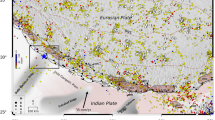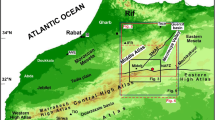Abstract
The Bhuj earthquake (26 January 2001) in India and the Ghori earthquake (8 October 2005) in Pakistan, both occurred close to the Indian-Iranian plate boundary related to the activity along the intercontinental Chaman transform fault. It is suggested that the seismic activity along NNW — NNE trending weak zones or faults is more intense in the sub-continent than along the WNW trending zones. Since the stress along the former is less compressive but more of the shear or translational type. The devastative Koyna (1967) and Latur (1993) earthquakes both occurred along faults or weak zones that were close to the meridional rather than the equatorial trend. The Indian plate is moving to the north or NNE or NNW, along a rotational trajectory and hence the force tends to be more compressive along the equatorial weak zones. In contrast, it tends to be less compressive and more of the shear or translational along the weak zones that are close to meridional trend. The seismic activity is therefore more intense along the weak zones with NNW to NNE trend than along the ENE to EW trending zones.
Similar content being viewed by others
References
Bendick, R., Bilhem, R., Fielding, E., Gaur, V.K., Hough, S., Kier, G., Kulkarni, M.N. Martin, S., Mueller, K. and Mukul, M. (2001) The January 26, 2001 “Republic Day”, Earthquake, India, Seism. Res. Lett., v.72(3), pp.328–335.
Gupta, M.K. (2003) An eye witness account of the Bhuj earthquake. Proc. Indian Acad. Sci. (Earth Planet. Sci.), v.112, No.3, pp.347–352.
Jade, S., Mukul, M., Pervez, LA., Ananda, M.B., Kumar, P.O., Gaur, V.K., Bendick, R., Bilham, R., Blume, F., Wallace, K., Abbasi, LA., Asif Khan, M. and Ulhadi, S. (2003) Preseismic, co-seismic and post seismic displacements associated with the Bhuj 2001 earthquake derived from recent and historic geodetic data. Proc. Indian Acad. Sci. (Earth Planet. Sci.), v.112, No.3, pp.331–345.
McKenzie, D.P. and Sclater, J.G. (1973) Evolution of the Indian Ocean. Scientific American.
Misra, K.S., Bhutani, R. and Sonp, R. (2003) Aftershocks of 26th Jan. 2001, Bhuj earthquake and Seismotectonics of the Kutch region, Proc. Indian Acad. Sci. (Earth Planet. Sci.), v.112,No.3, pp.385–390.
Valdiya, K.S. (1973) Tectonic framework of India: A review and interpretation of recent structural and tectonic studies. Geophys. Res. Bull., pp.79–105.
Websites: asc-india.org; cires.colorado.edu; earthquake.bgs.ac.uk; earthquake.usgs.gov; Geotimes.org.
Author information
Authors and Affiliations
Corresponding author
Rights and permissions
About this article
Cite this article
Purohit, M.K., Prajapati, K.K. Tectonic implications of the earthquakes in the Indian subcontinent. J Geol Soc India 73, 680–682 (2009). https://doi.org/10.1007/s12594-009-0052-6
Received:
Accepted:
Published:
Issue Date:
DOI: https://doi.org/10.1007/s12594-009-0052-6




